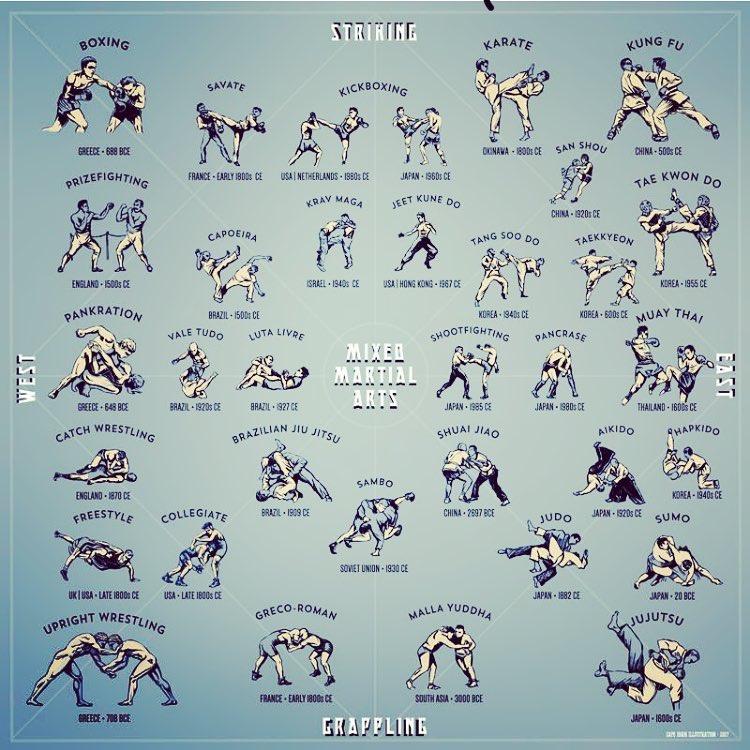The Journey And Transformation Of Martial Arts: Discovering Its Historic Structures And Contemporary Methods
The Journey And Transformation Of Martial Arts: Discovering Its Historic Structures And Contemporary Methods
Blog Article
Short Article Produced By-Busk Sommer
Enter the world of martial arts, where old origins and modern techniques clash in an exciting trip of technique and self-discovery.
As you explore the background and development of this fascinating art kind, prepare to be astounded by the cultural influences, technological developments, and profound ideology that have actually shaped it over centuries.
From the combat zones of ancient human beings to the training premises of today, martial arts have stood the test of time, constantly adjusting and growing.
Each strike, each motion, brings with it the weight of many years of practice and knowledge, passed down via generations. This is a tale of strength, of warriors that sought not just physical expertise, but also inner strength and consistency.
Join us on this remarkable exploration as we discover the tricks, the legends, and the transformational power of martial arts.
Get ready to be inspired, challenged, and for life transformed by the background and evolution of martial arts.
Cultural Influences on Martial Arts
As you explore the background and development of martial arts, you'll promptly uncover the fascinating ways in which social influences have actually shaped these fight techniques.
From More Information and facts of China and India to the more recent growths in Japan and Brazil, martial arts have been heavily affected by the societies in which they stemmed.
For instance, Chinese martial arts, such as Kung Fu and Tai Chi, are deeply rooted in the philosophy of Taoism and the principle of Yin and Yang.
On the other hand, Japanese martial arts, like Martial arts and Judo, reflect the samurai warrior customs and the worths of technique and honor.
In a similar way, Brazilian fighting style, Capoeira, integrates aspects of African dancing and music, showing the social heritage of African slaves in Brazil.
These cultural influences not only provide each martial art its unique attributes however additionally give a much deeper understanding of the historical and social contexts in which they advanced.
Technological Advancements and Martial Arts
With the surge of innovative weaponry and cutting-edge training tools, you've had the ability to improve your skills and adjust to the ever-changing fight landscape.
Technical improvements have actually changed the way martial arts are practiced and taught. martial arts and fitness stirchley allow you to train in practical fight circumstances without the danger of physical harm. High-speed video cameras catch every step, allowing you to assess and best your techniques. Wearable tools monitor your heart rate, breathing, and muscle activation, giving instantaneous feedback on your performance.
In addition, the development of specialized tools, such as resistance bands and agility ladders, has enabled you to improve your speed, toughness, and agility. These technological advancements have not only made training a lot more reliable however have actually additionally pushed the limits of what is feasible in martial arts, enabling you to get to new heights in your practice.
The Viewpoint and Principles of Martial Arts
The approach and concepts of martial arts are deeply rooted in shaping your mindset and instilling technique, emphasis, and regard in your technique.
1. Way of thinking: Martial Arts educates you to develop a strong and resistant way of thinking. It allows you to get over obstacles both on and off the mat, pressing your limitations and being determined despite hardship.
2. Self-control: Martial Arts demands self-control and self-control. Via normal training and adherence to rigorous policies and strategies, you find out to regulate your impulses and create a solid work ethic.
3. Focus: Martial Arts needs extreme focus and focus. By educating your mind to be present in the minute, you enhance your capacity to react swiftly and successfully throughout fight scenarios.
4. Regard: Martial Arts stresses regard for oneself, instructors, training partners, and challengers. It instructs you to value the skills and experiences of others, cultivating a sense of friendship and sportsmanship.
Final thought
Congratulations on finishing your journey with the exciting globe of martial arts! Throughout this expedition, you have experienced the abundant background and exceptional advancement of these battle practices.
From their old origins to the modern-day methods we see today, martial arts have been formed by social impacts.
The combination of technology has actually also played a considerable duty in revolutionizing the means martial arts are instructed and exercised in the present day.
However, it is necessary to keep in mind that martial arts are more than just physical fight. go now encompass profound philosophies and leading concepts that surpass the simple act of combating.
Take a moment to review this obsolete journey and appreciate just how the heritage of martial arts continues to prosper in the present, transcending time and limits.
